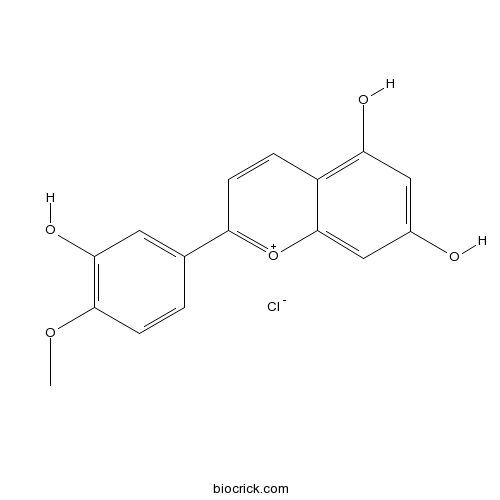Diosmetinidin chlorideCAS# 64670-94-6 |

Quality Control & MSDS
3D structure
Package In Stock
Number of papers citing our products

| Cas No. | 64670-94-6 | SDF | Download SDF |
| PubChem ID | 14842006 | Appearance | Powder |
| Formula | C16H13ClO5 | M.Wt | 320.7 |
| Type of Compound | Flavonoids | Storage | Desiccate at -20°C |
| Solubility | Soluble in Chloroform,Dichloromethane,Ethyl Acetate,DMSO,Acetone,etc. | ||
| Chemical Name | 2-(3-hydroxy-4-methoxyphenyl)chromenylium-5,7-diol;chloride | ||
| SMILES | COC1=C(C=C(C=C1)C2=[O+]C3=CC(=CC(=C3C=C2)O)O)O.[Cl-] | ||
| Standard InChIKey | OXTYCUBGMFGOAX-UHFFFAOYSA-N | ||
| Standard InChI | InChI=1S/C16H12O5.ClH/c1-20-15-4-2-9(6-13(15)19)14-5-3-11-12(18)7-10(17)8-16(11)21-14;/h2-8H,1H3,(H2-,17,18,19);1H | ||
| General tips | For obtaining a higher solubility , please warm the tube at 37 ℃ and shake it in the ultrasonic bath for a while.Stock solution can be stored below -20℃ for several months. We recommend that you prepare and use the solution on the same day. However, if the test schedule requires, the stock solutions can be prepared in advance, and the stock solution must be sealed and stored below -20℃. In general, the stock solution can be kept for several months. Before use, we recommend that you leave the vial at room temperature for at least an hour before opening it. |
||
| About Packaging | 1. The packaging of the product may be reversed during transportation, cause the high purity compounds to adhere to the neck or cap of the vial.Take the vail out of its packaging and shake gently until the compounds fall to the bottom of the vial. 2. For liquid products, please centrifuge at 500xg to gather the liquid to the bottom of the vial. 3. Try to avoid loss or contamination during the experiment. |
||
| Shipping Condition | Packaging according to customer requirements(5mg, 10mg, 20mg and more). Ship via FedEx, DHL, UPS, EMS or other couriers with RT, or blue ice upon request. | ||

Diosmetinidin chloride Dilution Calculator

Diosmetinidin chloride Molarity Calculator
| 1 mg | 5 mg | 10 mg | 20 mg | 25 mg | |
| 1 mM | 3.1182 mL | 15.5909 mL | 31.1818 mL | 62.3636 mL | 77.9545 mL |
| 5 mM | 0.6236 mL | 3.1182 mL | 6.2364 mL | 12.4727 mL | 15.5909 mL |
| 10 mM | 0.3118 mL | 1.5591 mL | 3.1182 mL | 6.2364 mL | 7.7954 mL |
| 50 mM | 0.0624 mL | 0.3118 mL | 0.6236 mL | 1.2473 mL | 1.5591 mL |
| 100 mM | 0.0312 mL | 0.1559 mL | 0.3118 mL | 0.6236 mL | 0.7795 mL |
| * Note: If you are in the process of experiment, it's necessary to make the dilution ratios of the samples. The dilution data above is only for reference. Normally, it's can get a better solubility within lower of Concentrations. | |||||

Calcutta University

University of Minnesota

University of Maryland School of Medicine

University of Illinois at Chicago

The Ohio State University

University of Zurich

Harvard University

Colorado State University

Auburn University

Yale University

Worcester Polytechnic Institute

Washington State University

Stanford University

University of Leipzig

Universidade da Beira Interior

The Institute of Cancer Research

Heidelberg University

University of Amsterdam

University of Auckland

TsingHua University

The University of Michigan

Miami University

DRURY University

Jilin University

Fudan University

Wuhan University

Sun Yat-sen University

Universite de Paris

Deemed University

Auckland University

The University of Tokyo

Korea University
- Luteolinidin chloride
Catalog No.:BCN9014
CAS No.:1154-78-5
- Gypenoside L
Catalog No.:BCN9013
CAS No.:94987-09-4
- 4-O-Cinnamoylquinic acid
Catalog No.:BCN9012
CAS No.:5509-70-6
- 4'-hydroxy-6,7,8,3'-tetramethoxyflavonol
Catalog No.:BCN9011
CAS No.:1879030-01-9
- Regaloside D
Catalog No.:BCN9010
CAS No.:120601-66-3
- Damulin A
Catalog No.:BCN9009
CAS No.:1202868-74-3
- Achyranthoside D
Catalog No.:BCN9008
CAS No.:168009-91-4
- Delphinidin-3-O-rhamnoside chloride
Catalog No.:BCN9006
CAS No.:29907-19-5
- Peonidin-3-O-rutinoside chloride
Catalog No.:BCN9005
CAS No.:27539-32-8
- Cyanidin-3-O-sambubioside-5-O-glucoside chloride
Catalog No.:BCN9003
CAS No.:53925-33-0
- Apigeninidin chloride
Catalog No.:BCN9002
CAS No.:1151-98-0
- Fisetinidin chloride
Catalog No.:BCN9001
CAS No.:2948-76-7
- Cyanidin-3-O-lathyroside chloride
Catalog No.:BCN9016
CAS No.:31073-32-2
- Delphinidin-3-O-sambubioside-5-O-glucoside chloride
Catalog No.:BCN9017
CAS No.:36415-91-5
- Isofutoquinol A
Catalog No.:BCN9018
CAS No.:62499-70-1
- Regaloside B
Catalog No.:BCN9019
CAS No.:114420-67-6
- Regaloside A
Catalog No.:BCN9020
CAS No.:114420-66-5
- Guibourtinidin chloride
Catalog No.:BCN9021
CAS No.:23130-31-6
- Peonidin-3,5-O-diglucoside chloride
Catalog No.:BCN9022
CAS No.:132-37-6
- (+)-Mediresinol Di-O-beta-D-glucopyranoside
Catalog No.:BCN9023
CAS No.:88142-63-6
- Robinetinidin chloride
Catalog No.:BCN9024
CAS No.:3020-09-5
- Sipeimine-3-beta-D-glucoside
Catalog No.:BCN9025
CAS No.:67968-40-5
- Cyanidin-3-O-(6''-malonylglucoside) chloride
Catalog No.:BCN9026
CAS No.:171828-62-9
- (-)-Carvone
Catalog No.:BCN8949
CAS No.:6485-40-1
(13)C CPMAS NMR and DFT calculations of anthocyanidins.[Pubmed:18657953]
Solid State Nucl Magn Reson. 2008 Jul-Sep;34(1-2):44-51.
Anthocyanidins, red dyes from flower petals and fruits, are beneficial to human health. They attract considerable attention owing to their strong antioxidant and radical scavenging properties, however they are unstable in solution and available in small amounts only. (13)C CP MAS NMR spectra were recorded to characterize solid-state conformation of nine anthocyanidins: apigenidin, pelargonidin, cyanidin, delphinidin, peonidin, malvidin robinetidin, luteolinidin and Diosmetinidin chlorides. For some carbons, the solid-state chemical shifts were different from those obtained for solutions, indicating differences in conformation and intermolecular interactions. The principal elements of the (13)C chemical shift tensor were measured for pelargonidin, cyanidin, delphinidin and malvidin chlorides using PASS-2D NMR technique. DFT GIAO calculations of shielding constants were performed for apigenidin and several geometric isomers of pelargonidin. Comparison of experimental (13)C delta(ii) with the theoretical shielding parameters was helpful in predicting the most reliable geometry in the solid state. The cross-polarization parameters were obtained from variable-contact time experiments; T(CH) are longer and the values of T(1)(rho)(H) are shorter in the order: pelargonidin


